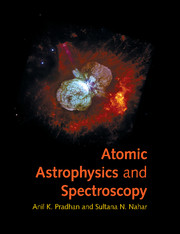Book contents
- Frontmatter
- Contents
- Preface
- Acknowledgements
- 1 Introduction
- 2 Atomic structure
- 3 Atomic processes
- 4 Radiative transitions
- 5 Electron–ion collisions
- 6 Photoionization
- 7 Electron–ion recombination
- 8 Multi-wavelength emission spectra
- 9 Absorption lines and radiative transfer
- 10 Stellar properties and spectra
- 11 Opacity and radiative forces
- 12 Gaseous nebulae and H II regions
- 13 Active galactic nuclei and quasars
- 14 Cosmology
- Appendix A Periodic table
- Appendix B Physical constants
- Appendix C Angular algebra and generalized radiative transitions
- Appendix D Coefficients of the fine structure components of an LS multiplet
- Appendix E Effective collision strengths and A-values
- References
- Index
9 - Absorption lines and radiative transfer
Published online by Cambridge University Press: 05 June 2012
- Frontmatter
- Contents
- Preface
- Acknowledgements
- 1 Introduction
- 2 Atomic structure
- 3 Atomic processes
- 4 Radiative transitions
- 5 Electron–ion collisions
- 6 Photoionization
- 7 Electron–ion recombination
- 8 Multi-wavelength emission spectra
- 9 Absorption lines and radiative transfer
- 10 Stellar properties and spectra
- 11 Opacity and radiative forces
- 12 Gaseous nebulae and H II regions
- 13 Active galactic nuclei and quasars
- 14 Cosmology
- Appendix A Periodic table
- Appendix B Physical constants
- Appendix C Angular algebra and generalized radiative transitions
- Appendix D Coefficients of the fine structure components of an LS multiplet
- Appendix E Effective collision strengths and A-values
- References
- Index
Summary
Among the most extensive applications of atomic physics in astronomy is the precise computation of transfer of radiation from a source through matter. The physical problem depends in part on the bulk temperature and density of the medium through which radiation is propagating. Whether the medium is relatively transparent or opaque (‘thin’ or ‘thick’) depends not only on the temperature and the density, but also on the atomic constituents of matter interacting with the incident radiation via absorption, emission and scattering of radiation by particular atomic species in the media. Since optical lines in the visible range of the spectrum are most commonly observed, the degree of transparency or opaqueness of matter is referred to as optically thin or optically thick. However, it must be borne in mind that in general we need to ascertain radiative transfer in all wavelength ranges, not just the optical. Macroscopically, we refer to optical thickness of a whole medium, such as a stellar atmosphere. But often one may observe a particular line and attempt to ascertain whether it is optically thick or thin in traversing the entire medium.
Radiative transfer and atomic physics underpin quantitative spectroscopy. But together they assume different levels of complexity when applied to practical astrophysical situations. Significantly different treatments are adopted in models for various astrophysical media. At low densities, prevalent in the interstellar medium (ISM) or nebulae, ne <; 106 cm-3, the plasma is generally optically thin (except for some strong lines, such as the Lyα, that do saturate), and consideration of detailed radiative transfer effects is not necessary.
- Type
- Chapter
- Information
- Atomic Astrophysics and Spectroscopy , pp. 194 - 219Publisher: Cambridge University PressPrint publication year: 2011

